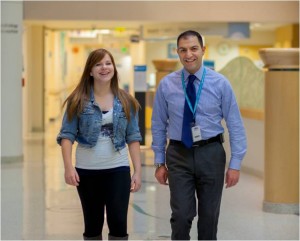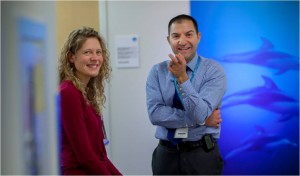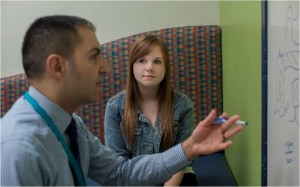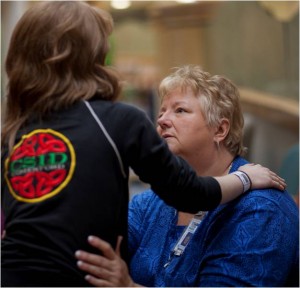
Paige Norris’s young life seemed to be sailing along with fair winds and sunny skies. At 10 years old she was an enthusiastic tennis player with lots of friends and a stellar academic life – two years ahead in every subject.
But sometime in fourth grade her internal weather shifted, and she developed debilitating abdominal pain.
Her parents felt helpless as doctors downplayed Paige’s symptoms. “It was so frustrating to hear condescending advice like, ‘kids have stomach issues; she’ll get over it,’” recalls Deborah Norris. “But I know my daughter, and she’s not a complainer.”
Paige’s condition worsened as mysterious bouts of vomiting and diarrhea sapped her energy. She stopped growing, lost 20 pounds, and had to quit her favorite sport.
Finally, when Paige was 11 and starting sixth grade, blood tests and a colonoscopy at Seattle Children’s Hospital revealed that she was suffering from Crohn’s disease, one of a group of autoimmune disorders known as inflammatory bowel disease (IBD).
A relationship gone bad
A healthy gut depends on a happy balance between the immune system and the bacteria that inhabit the bowel (known as the microbiome). Normally, our immune system “wakes up” only when it’s needed to fight off invasive bacteria, forcing it out with vomiting and diarrhea. When the job is done, the immune system stops those symptoms.
But for reasons that are still unclear (perhaps a genetic predisposition or a trigger that upsets the balance), the relationship between the immune system and microbiome sometimes goes haywire. If the immune response doesn’t shut off or the bacterial imbalance can’t be righted, the different layers of the GI tract become chronically inflamed and the body can’t retain nutrients.
Because the average age at diagnosis is 12 – right on the cusp of adolescence – pediatric IBD jeopardizes crucial milestones for growth, puberty, bone density, and emotional and social development.
“We’ve got a critical window of time to get kids with IBD back on track,” says Dr. Ghassan Wahbeh, who leads Seattle Children’s IBD Center. “And the worst thing that could happen to a teenager is pretty much everything that IBD is. You get embarrassing symptoms. You get singled out because you have to use the bathroom and interrupt your class. Your participation in sports is limited. And everybody is in your business, asking about your bowel movements, right when your developmental stage dictates that you gain more independence and privacy.”
The best of both worlds

The IBD Center brings together all the elements needed to treat IBD comprehensively and meet the particular needs of teens and young adults. That means supporting patients’ autonomy and having a diverse and robust arsenal of therapies.
“Our focus is on quality of life over the course of the disease,” says Wahbeh. “Because treatments may work for a while, then stop working, it’s very important to be able to offer the full array of options and to be actively researching new ones.”
Steroids reduce inflammation and the pain it causes, so they have often been used to treat IBD. But they don’t effectively heal the inflamed layers of the intestine, and prolonged use invites a troubling list of side effects.
“Our goal is to keep kids off steroids,” says Wahbeh. “There’s mounting evidence that we have better healing tools, and some of them are in the form of nutrition. So we design our treatment plans to use the best of both worlds: the best of the diet and the best of the medications.”
Studies show that an entirely liquid diet for six to eight weeks causes remission in up to 85% of children with newly diagnosed Crohn’s disease. Though it’s not yet clear why it works, the liquid diet helps heal the intestine and get kids back on track in terms of height and weight. Widely used in Europe and Canada, the approach has only recently become culturally acceptable as a first-line treatment in the United States.

Norris recalls the day Wahbeh laid out Paige’s treatment options: steroids or the liquid diet. “He talked directly to her, and didn’t scare her about steroids – he was very even-handed and let Paige decide.”
The liquid diet – six and a half cans of Strawberry Ensure a day – turned Paige’s health around. Within just a couple of weeks, her energy returned and tests showed her inflammation subsiding. Her disease went into remission.
But once Paige started eating solid food again, the inflammation came back, as it does with about half the kids who do the liquid diet. After trying a couple of different medications, Paige and her parents opted for an anti-inflammatory, non-steroid therapy administered intravenously every other month. The effect was dramatic: within a few days, Paige was out on the family trampoline. “It was a complete transformation. The infusions let Paige go for weeks without having to think much about having Crohn’s,” says her mom.
Now 14 and again in remission, Paige has the energy to participate in the things she loves. She’s back on the tennis court and playing sax in her school’s pep band.
“The care at Seattle Children’s feels really personal, and I know they value my opinion,” says Paige. “It’s my body that’s being affected, so it’s good to have a big say in what happens to it.”
A marathon, not a sprint

For Ann and Bill Moore, seeing their son Tom head off to college at Eastern Washington University was one of the most important milestones in his 10-year journey with Crohn’s disease – and one of the hardest. Tom’s been on several different medications over the years and had surgery to remove part of his colon. The usual stresses of starting college would be compounded by managing his disease on his own.
Fortunately, Tom has allies in the transition, including Teresa Wachs, the nurse who’s been a nurturing and knowledgeable partner in his treatment since the very beginning. “She met with me before I left for Cheney,” recalls Tom. “And she’d put together this binder – my whole health history, all in one place – as a resource. She knows knowledge is power with this disease, and she and Dr. Wahbeh have always made me feel like I’m in charge of my treatment.”
Wachs and Wahbeh keep their eyes on the big picture, notes Tom’s dad. “Their message to Tom is, it’s a marathon, not a sprint: you’re going to have to figure out every day how to do this. We’ll help you, but it’s up to you what your life is like with Crohn’s.”
Resources:
- Seattle Children’s Inflammatory Bowl Disease Center
- Seattle Children’s Gastroenterology and Hepatology Program

